The era of untethered growth within the Buy-Now-Pay-Later (BNPL) market may be coming to an end as the Consumer Financial Protection Bureau (CFPB) turns a critical eye toward the industry, resulting from growing concerns about consumer financial health.
The global BNPL market size was estimated at $141.8 billion in 2021 and projected to grow at a compound annual growth rate of 33.3 percent through 20261. What has fueled this unconstrained boom? Aside from lenient regulations, the deceptively simple approval process for consumers has dissolved an otherwise clunky lending approval experience.
The CFPB is considering new rules surrounding BNPL with the goal of increasing consumer transparency, including specific disclosure requirements on installment agreements2. There is also a growing expectation that the CFPB will push BNPL providers to submit transaction information to credit reporting agencies. These additional regulatory requirements will likely increase operating costs for BNPL companies and levels the playing field, thereby opening the door for traditional financial institutions to reclaim the market. Consumer expectations have shifted due to their experiences with these firms, and financial institutions will need to re-examine their lending experiences to bring those customers back into the fold.

Leveraging Data for Decisioning & Cross-Selling
Financial firms already know so much about their customers from data that spans address and mortgage dues to payees and purchase history. That information can build a holistic digital profile to not only support lending decisions, but also generate triggers to capture additional share of wallet. Customer data collection is just the starting point – firms also need to develop content and data-driven strategies to align with customer journeys and offer options at key points and lifecycle milestones. BNPL companies don’t have access to the same breadth of data found in traditional financial firms, but their innovations in applying artificial intelligence (AI) and machine learning (ML) to available data have given them a competitive advantage in tailoring lending offers and options.
Take a page out of the BNPL playbook — applying AI and ML engines can continually improve both the speed and accuracy of customer data and analytics. This could enable automated credit approval using ML models that are trained on customer data such as payment history, purchases, and exposures. These models could also shed some light on customers’ outgoing BNPL payments, something that is currently a blind spot due to the lack of BNPL reporting to the major credit bureaus. Using these methods, traditional firms can identify a debt-to-income risk and proactively reach out to a customer to discuss debt consolidation options to improve their financial situation and mitigate risk to the bank.
Enhancing the Customer Experience
Millennials and Gen Z account for the largest portion of BNPL users — 44% of all Gen Z shoppers and 37% of millennial shoppers are likely to use BNPL at least once in the next year3. For these demographics, convenience has been a key driver for adoption. The BNPL customer experience is simple, convenient, and fast. BNPL borrowers can purchase a product and pay nothing when checking out, which hides the complexity of the loan’s fees under a frictionless, intuitive point of sale experience. This customer-centered experience should be embedded in traditional financial services products from the initial interaction to the final transaction. American Express, for example, partnered with fintech Opy to launch their own competing BNPL products, prompting customers to break up large purchases into monthly installments directly through the app rather than through fintech providers during checkout.
To compete with the instant-gratification BNPL experience, financial institutions can leverage technology, data, analytics, and cloud solutions to deliver insights with speed and accuracy. Additionally, customer expectations now extend beyond the transactional to include consider their institution’s financial wellness capabilities. Examining a traditional firm’s financial wellness offering may uncover opportunities to better connect with customers digitally, such as humanizing the lending experience with a virtual assistant to suggest products to an existing client with real-time loan approval based on their profile data.
Keeping Up with Customer Demand
As financial institutions adjust to ever-changing customer preferences, they must remain nimble if they want to stay competitive. Essentially implementing organizational and operational methodologies that enable speedy product releases to keep up with constantly shifting customer needs. Fintechs historically have proven better than traditional firms at iterative delivery because they employ a consistent framework to enable continuous interplay across their product, research, and development teams.
This framework, known as the Agile methodology, enables product teams to work closely with research teams to understand evolving customer lending needs and translate them into prioritized roadmap initiatives. Scrum masters help manage the program to ensure timelines are met and diffuse unnecessary blockers. Development teams are placed into squads and work closely with the product team in predefined sprint periods to deliver new code launches and iterative improvements to existing products. An Agile methodology can enable organizations to launch a minimum viable product to market much faster and better prioritize features based on research and customer needs by orchestrating streamlined collaboration across teams. Ultimately, all financial firms’ internal operations exist somewhere on the spectrum of waterfall to Agile, but finding the methodology that works best for the organization is critical for aligning product strategy with customer retention and acquisition.
BNPL has undoubtedly established a foothold in the market and is here to stay. However, regulations have finally caught up to lending consumer needs, and traditional firms that act now can fully capitalize on this inflection point and drive market share.
_________________________________
1. https://www.globaldata.com/store/report/buy-now-pay-later-market-analysis/#:~:text=The%20Buy%20Now%20Pay%20Later%20(BNPL)%20market%20size%20was%20valued,thereby%20favoring%20BNPL%20market%20growth
2. https://www.consumerfinance.gov/about-us/newsroom/cfpb-study-details-the-rapid-growth-of-buy-now-pay-later-lending/
3. https://www.pymnts.com/buy-now-pay-later/2022/millennials-gen-z-fueling-bnpl-use/